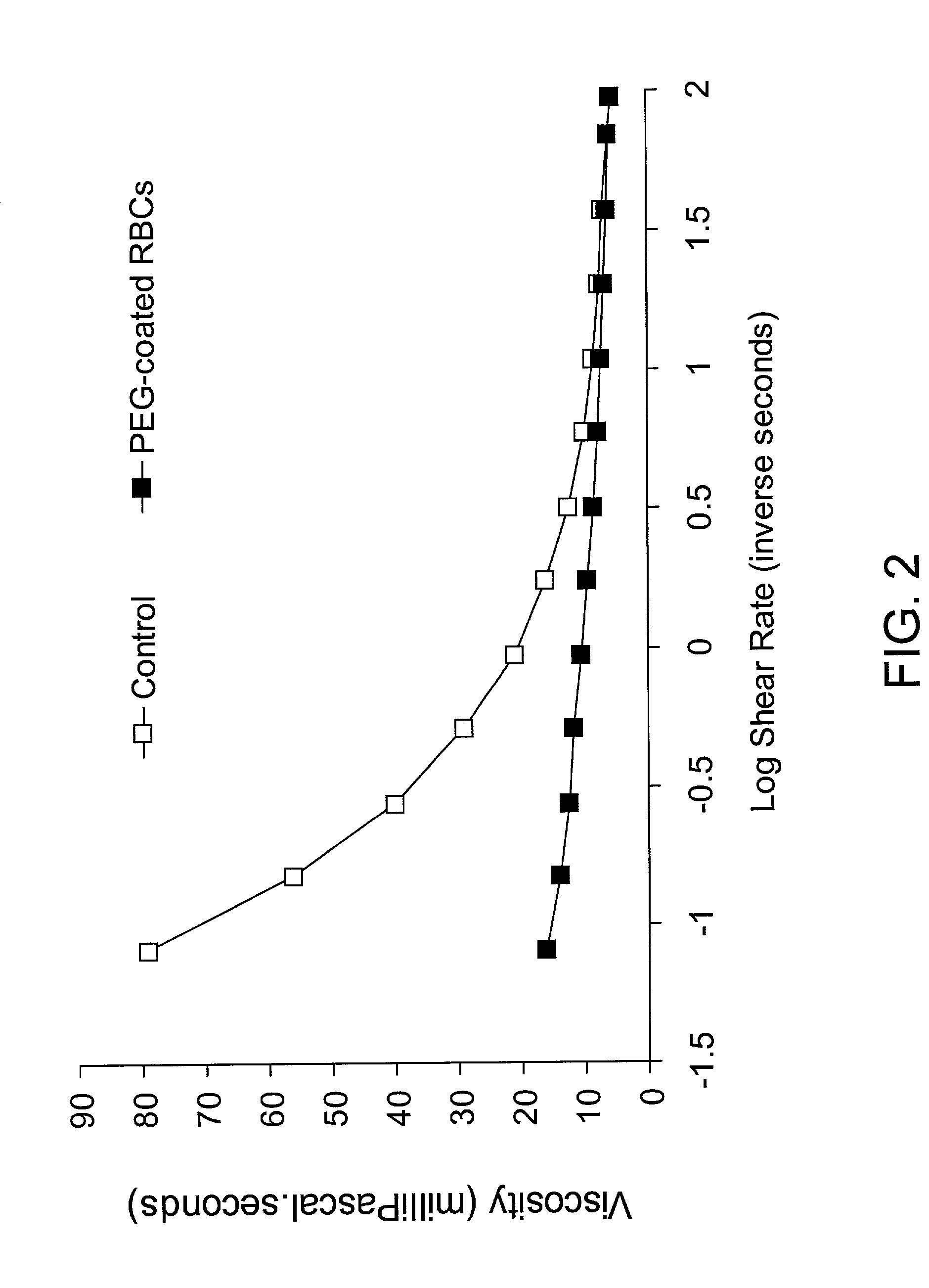Red blood cells covalently bound with polymers
a technology of red blood cells and polymers, which is applied in the field of red blood cells covalently bound with polymers, can solve the problems of serious transfusion reactions, changes in flow characteristics of rbcs that can exert profound effects on the body, and can deteriorate so as to preserve the function and viability of rbc, reduce or abolish rbc-rbc aggregation, and reduce blood viscosity
- Summary
- Abstract
- Description
- Claims
- Application Information
AI Technical Summary
Benefits of technology
Problems solved by technology
Method used
Image
Examples
example 1
[0040] Reduction of Blood Viscosity by PEG-Modified RBC
[0041] Referring to FIG. 2, the effect of PEG-coating on whole blood viscosity is shown. The viscosity of control RBC and PEG-coated RBC were compared over a range of shear rates using a Couette viscometer (Contraves LS30, Contraves AG, Switzerland). The control RBC show a typical steep change in viscosity with shear rate. In contrast, the viscosity for the PEG-coated RBC (lower curve) showed very little shear dependence, i.e., the blood behaved in a nearly Newtonian manner, consistent with the complete elimination of RBC-RBC aggregation. At the higher shear rates(10-100 sec.sup.-1),the curves for control and PEG-coated RBC exactly converged. Given that the hematocrit and plasma viscosity were identical for the two samples, this confirms that the RBC deformability was not altered by the PEG-coating. Note that the amount of bound PEG required to abolish RBC aggregation and minimize low shear viscosity is much lower than that requ...
example 2
[0044] Masking of Blood Group Antigens by PEG-Modification of RBC
[0045] The extent of antigen masking that could be achieved by PEG coating was examined using the PEG-CN derivatives described above, alone and in combination, over a range of concentrations. Standard blood bank serology techniques (agglutination testing) were used for the initial screening of antigen masking; blockade of antibody binding was later quantified directly by flow cytometry,
[0046] Agglutination studies were conducted using a standard tube test, with antisera (Immucor Inc., Norcross, Ga. and Gamma Biologicals Inc., Houston, Tx.) to a selected range of antigens from the Rh and other blood groups, many of which are commonly implicated in delayed hemolytic transfusion actions. The standard glass tube was pre-coated with human serum albumin (HSA) by rinsing with APES (Sigma Chemical Co., St. Louis, Mo.), washing with water, soaking in 3% HSA in PBS for 5 min., and finally rinsing with water and allowing to dry b...
example 3
[0060] Inhibition of RBC Aggregation by PEG Modification of RBC
[0061] In addition to the antigen masking effects described above, the attachment of PEG also strongly inhibits the aggregation of RBC. The aggregation of RBC in autologous plasma was measured using a Myrenne Aggregometer (Myrenne GmbH, Roetgen, Germany), an instrument which quantifies RBC aggregation by measuring the rate of change of light transmission through a sheared blood sample R. M. Bauersachs, R. B. Wenby and H. J. Meiselman, Determination of specific red blood cell indices via an automated system, Clin. Hemorheol, 9(1989) 1-25). PEG-coated RBC were prepared as described above (control RBC were incubated in buffer alone), after which both PEG-coated and control RBC were resuspended in autologous plasma at 40% hematocrit. Referring to FIG. 6, the effect of incubating RBC with increasing concentrations of mPEG-CN 5000 is shown. RBC aggregation decreased with increasing PEG concentration, and was abolished at a con...
PUM
 Login to View More
Login to View More Abstract
Description
Claims
Application Information
 Login to View More
Login to View More - R&D
- Intellectual Property
- Life Sciences
- Materials
- Tech Scout
- Unparalleled Data Quality
- Higher Quality Content
- 60% Fewer Hallucinations
Browse by: Latest US Patents, China's latest patents, Technical Efficacy Thesaurus, Application Domain, Technology Topic, Popular Technical Reports.
© 2025 PatSnap. All rights reserved.Legal|Privacy policy|Modern Slavery Act Transparency Statement|Sitemap|About US| Contact US: help@patsnap.com



